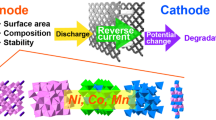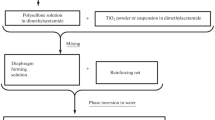Abstract
The influences of tetraborate anions on manganese electrodeposition in an anion-exchange membrane electrolysis reactor were investigated. The experimental results of manganese electrodeposition indicate that a certain amount of tetraborate anions can increase cathode current efficiency and initial pH 7.0–8.0 is suitable for high cathode current efficiency. X-ray diffraction (XRD) and scanning electron microscope (SEM) analysis show the nanocrystalline structure and impact morphology of electrodeposited manganese. The purity of electrodeposited manganese is above 99.88 %. The tests of tetraborate anions on buffer capacity (β) and pH value of the electrolyte near the cathode surface confirm that tetraborate anions facilitate manganese electrodeposition. Tetraborate anions can improve concentration polarization of Mn2+ ions and then increase the overpotential of hydrogen evolution reaction. Therefore, ammonium tetraborate can reduce the hydrogen embrittlement, pore, and pitting negative effect on electrodeposit surface, to improve the corrosion resistance of electrodeposited manganese. After tetraborate anions being added in electrolyte, weight loss measurement indicates that the corrosion resistance of electrodeposited manganese is improved. Electrochemical measurements testify that corrosion resistance of electrodeposited manganese containing tetraborate anions in electrolyte is reflected by less negative corrosion potential and higher impedance.














Similar content being viewed by others
References
Deepti SP, Sanjay MC, John UKO (2016) A review of technologies for manganese removal from wastewaters. Chem Eng J 4:468–487
Aguilar C, Guzman P, Lascano S, Parra C, Bejar L, Medina A, Guzman D (2016) Solid solution and amorphous phase in Ti-Nb-Ta-Mn systems synthesized by mechanical alloying. J Alloy Compd 670:346–355
Araujo JAMD, Castro MDMRD, Lins VDFC (2006) Reuse of furnace fines of ferro alloy in the electrolytic manganese production. Hydrometallurgy 84:204–210
Lu JM, Dreisinger D, Glück T (2014) Manganese electrodeposition-a literature review. Hydrometallurgy 141:105–116
Wei QF, Ren XL, Du J, Wei SJ, Hu SR (2010) Study of the electrodeposition conditions of metallic manganese in an electrolytic membrane reactor. Miner Eng 23:578–586
Gamali IV, Stender VV (1967) Effect of sulfite and selenite ions on the electrodeposition of manganese from solutions containing certain organic compounds. J Appl Chem USSR (English translation edition) 40:307–310
Ding LF, Fan X, Du J, Liu ZH, Tao CY (2014) Influence of three N-based auxiliary additives during the electrodeposition of manganese. Int J Miner Process 130:34–41
Galvanauskaite N, Sulcius A, Griskonis E, Diaz-Arista P (2011) Influence of Te(VI) additive on manganese electrodeposition at room temperature and coating properties. Trans Inst Metal Finish 89:325–332
Griškonis E, Šulčius A, Žmuidzinavičienė N (2014) Influence of temperature on the properties of Mn coatings electrodeposited from the electrolyte containing Te(VI) additive. J Appl Electrochem 44:1117–1125
Gong J, Zangari G (2002) Electrodeposition and characterization of manganese coatings. J Electrochem Soc 149:209–217
Ren XL, Wei QF, Hu SR, Wei SJ (2010) The recovery of zinc from hot galvanizing slag in an anion-exchange membrane electrolysis reactor. J Hazard Mater 181:908–915
Ren XL, Wei QF, Liu Z, Liu J (2012) Electrodeposition conditions of metallic nickel in electrolytic membrane reactor. T Nonferr Metal Soc China 22:467–475
Carrillo-Abad J, García-Gabaldón M, Ortega E, Pérez-Herranz V (2012) Recovery of zinc from spent pickling solutions using an electrochemical reactor in presence and absence of an anion-exchange membrane: Galvanostatic operation. Sep Puri Technol 98:366–374
Wu Y, Chang D, Kim D, Kwon SC (2003) Influence of boric acid on the electrodepositing process and structures of Ni-W alloy coating. Surf Coat Tech 173:259–264
Ji J, Cooper WC, Dreisinger DB, Peters E (1995) Surface pH measurements during nickel electrodeposition. J Appl Electrochem 25:642–650
Tilak BV, Gendron AS, Mosoiu MA (1977) Borate buffer equilibria in nickel refining electrolytes. J Appl Electrochem 7:495–500
Berger R, Bexell U, Grehk TM, Hörnström SE (2007) A comparative study of the corrosion protective properties of chromium and chromium free passivation methods. Surf Coat Tech 202:391–397
Liu J, Guo Y, Huang W (2006) Study on the corrosion resistance of phytic acid conversion coating for magnesium alloys. Surf Coat Tech 201:1536–1541
Morales J, Fernandez GT, Esparza P, Gonzalez S, Salvarezza RC (1995) A comparative study on the passivation and localized corrosion of α, β, and α + β brass in borate buffer solutions containing sodium chloride-I. Electrochemical data. Corros Sci 37:211–229
Nayana KO, Venkatesha TV, Chandrappa KG (2013) Influence of additive on nanocrystalline, bright Zn-Fe alloy electrodeposition and its properties. Surf Coat Tech 235:461–468
Shi Z, Liu M, Atrens A (2010) Measurement of the corrosion rate of magnesium alloys using Tafel extrapolation. Corro Sci 52:579–588
Mohammadi S, Taromi FA, Shariatpanahi H, Neshati J, Hemmati M (2014) Electrochemical and anticorrosion behavior of functionalized graphite nanoplatelets epoxy coating. J Ind Eng Chem 20:4124–4139
Schneider M, Kremmer K, Lämmel C, Sempf K, Herrmann M (2014) Galvanic corrosion of metal/ceramic coupling. Corros Sci 80:191–196
Agarwal S, Curtin J, Duffy B, Jaiswal S (2016) Biodegradable magnesium alloys for orthopaedic applications: a review on corrosion, biocompatibility and surface modifications. Mat Sci Eng C 68:948–963
Sun WY, Su SJ, Wang QY, Ding SL (2013) Lab-scale circulation process of electrolytic manganese production with low-grade pyrolusite leaching by SO2. Hydrometallurgy 133:118–125
Deng FY, Li SB, Jiang SQ, Zhang FE, Wang K (2010) Method for measuring content of boron element contained in aluminium-titanium-boron alloy. Chinese patent (CN) 101813620 A:1–10
Rudnik E (2015) Effect of gluconate ions on electroreduction phenomena during manganese deposition on glassy carbon in acidic chloride and sulfate solutions. J Electroanal Chem 741:20–31
Parys HV, Telias G, Nedashkivskyi V (2010) On the modeling of electrochemical systems with simultaneous gas evolution. Case study: the zinc deposition mechanism. Electrochim Acta 55:5709–5718
Neumair SC, Perfler L, Huppertz H (2014) Synthesis and characterization of the manganese borate α-MnB2O4. Z Naturforsch B 66:882–888
Lu J, Yang QH, Zhang Z (2010) Effects of additives on nickel electrowinning from sulfate system. T Nonferr Metal Soc China 20:97–101
Raeissi K, Golozar MA, Szpunar JA, Tufani A, Saatchi A (2008) Texture and surface morphology development in zinc and zinc-cobalt electrodeposits. J Electrochem Soc 155:783–790
Pourbaix M (1997) Atlas of electrochemical equilibriam in aqueous solutions. NACE International Cebeleor 56:562–567
Bard AJ, Parsons R, Jordan J (1985) Standard potentials in aqueous solution. Marcel Dekker, New York
Lupi C, Pasquali M, Era AD (2006) Studies concerning nickel electrowinning from acidic and alkaline electrolytes. Miner Eng 19:1246–1250
Zech N, Landolt D (2000) The influence of boric acid and sulfate ions on the hydrogen formation in Ni-Fe plating electrolytes. Electrochim Acta 45:3461–3471
Baes CF, Mesmer RE (1976) The hydrolysis of cations. Wiley, New York
Tilak BVKSRA, Rajagopalan SR, Reddy AKN (1962) Buffer characteristics of manganous sulphate + ammonium sulphate electrodeposition baths. Trans Faraday Soc 58:795–804
Hammouti B, Dafali A, Touzani R, Bouachrine M (2012) Inhibition of copper corrosion by bipyrazole compound in aerated 3 % NaCl. J Saudi Chem Soc 16:413–418
Zhang E, Chen H, Shen F (2010) Biocorrosion properties and blood and cell compatibility of pure iron as a biodegradable biomaterial. J Mater Sci Mater Med 21:2151–2163
Song S, Song GL, Shen W, Liu M (2012) Corrosion and electrochemical evaluation of coated magnesium alloys. Corros J Sci Eng 68:015005–015011
Gu KM, Lv LY, Lu ZL, Yang HP, Mao F, Tang JN (2013) Electrochemical corrosion and impedance study of SAE1045 steel under gel-like environment. Corro Sci 74:408–413
Poursaee A (2010) Potentiostatic transient technique, a simple approach to estimate the corrosion current density and stern-Geary constant of reinforcing steel in concrete. Cement Concrete Res 40:1451–1458
Cao ZL, Hibino M, Goda H (2013) Effect of nitrite ions on steel corrosion induced by chloride or sulfate ions. Int J Corro 2013:1–16
Acknowledgments
The authors would like to thank the National Natural Science Foundation of China (No. 21376273) and the National Science and Technology Support Program of China (No. 2015BAB17B01) for offering the research funds.
Author information
Authors and Affiliations
Corresponding authors
Rights and permissions
About this article
Cite this article
Xue, J.R., Zhong, H..., Wang, S. et al. Influence of tetraborate anions on manganese electrodeposition in an anion-exchange membrane electrolysis reactor. Ionics 23, 177–189 (2017). https://doi.org/10.1007/s11581-016-1793-z
Received:
Revised:
Accepted:
Published:
Issue Date:
DOI: https://doi.org/10.1007/s11581-016-1793-z




